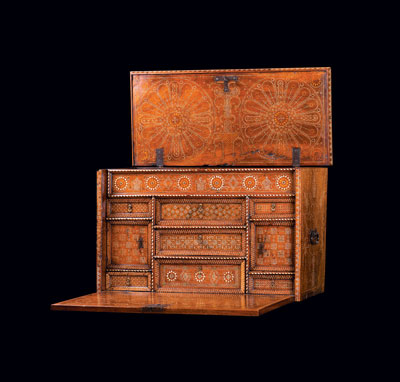Something to Write Home About
Writer Leslie Gilbert ElmanThe vargueño is the “most Spanish of Spanish furniture.”
To call a vargueño a “portable writing desk” deprives it of the admiration it deserves. Even if it originally was designed to be transported from place to place—strongly constructed with sturdy iron drop handles, hinges and hasps—the vargueño was never a mere piece of baggage. It has always been a work of art.
Dating back to the 15th century, possibly to the town of Bargas, near Toledo, Spain, the vargueño (or bargueño, from Bargas) in its earliest incarnation was intended as a traveling chest to hold important documents and letters, with a front side that folded out to offer a smooth writing surface. Rugged and practical, it didn’t take long for vargueños to become beautiful as well.
“In principle, the vargueño cabinet was nothing but a rectangular box with one side hinged at the bottom,” Harold Donaldson Eberlein wrote in The Spur in 1928. “When this hinged side was let down it disclosed tiers of little sliding drawers which, later on, were supplemented by several pigeonholes or by a little cupboard with a door.”
And that’s when the surprises were revealed. For while the exterior of the vargueño might appear relatively plain save for some fancy ironwork (often over red velvet!), the interior was elaborately detailed, usually in Moorish style, with gilded decoration, carving, bone inlay and paint.
The vargueño is arguably the single most iconic Spanish furniture form. No other country originated anything exactly like it. Usually made from walnut and heavy with decoration, both literally and figuratively, by the 16th and 17th centuries vargueños often were crafted with matching bases to hold them—a table, a stand or even a chest of drawers.
“When open, the effect is one of flamboyant splendor,” Grace Hardendorff Burr, former curator of furniture of the Hispanic Society of America, wrote in her 1964 book Hispanic Furniture. “Anyone with a pretension to wealth must have owned a vargueño during the seventeenth century, as writing cabinets are mentioned so often in household inventories, and so many are still in existence.”
It’s hard to imagine some of those ornate vargueños being toted from place to place, nevertheless, they almost always were equipped with their characteristic iron side handles and hasps. The style survived into the 19th century; there’s even some evidence that the name “vargueño” only went into common use at that time.
Spanish Revival
Fast-forward to the 1920s, when Spanish or Mission-style architecture was all the rage in the United States. New buildings with stucco exteriors and tile roofs rose everywhere from southern California to New Jersey (the now-landmarked Ridgewood train station, for instance). Even Sears was selling prefab home kits in the Spanish style.
That fashion led to a new, enthusiastic demand for antique vargueños. At auctions of Spanish furniture and decorative arts, vargueños routinely commanded the highest price of any object in the sale.
“It’s a cupboard raised to a higher power,” esteemed art critic Royal Cortissoz wrote in the New York Tribune in 1922. “Unique both inside and out, often prodigiously ingenious and complicated in detail and always richly decorative.”
In 1926, the New York Times decreed: “If you have a Spanish interior, you must have a vargueño. This is the most Spanish of Spanish furniture.”
Lord & Taylor, which dabbled in antiques at the time, advertised a 17th century vargueño writing desk for $900. In California, Barker Bros. furniture stores offered modern reproduction vargueño-style desks for $97.50.
The allure of the vargueño even extended beyond home furnishings. Dodge introduced new model cars for 1930 in a shade called Vargueno brown from “the deep reddish brown casts of an old Spanish vargueño cabinet.” Vargueños were in vogue again—literally—as in a Vogue magazine advertisement for Towle Silversmiths’ “Seville” pattern adapted “from the finely wrought design on one of those old Spanish chests called vargueños (var-gayn-yos).”
Today, those so-called “old Spanish chests” have pride of place in museum collections, and when they come up at auction, they routinely sell for well above estimate—still desired and deservedly admired.
Leslie Gilbert Elman is the author of Weird But True: 200 Astounding, Outrageous and Totally Off the Wall Facts. She writes about antiques and other subjects for Design NJ.


